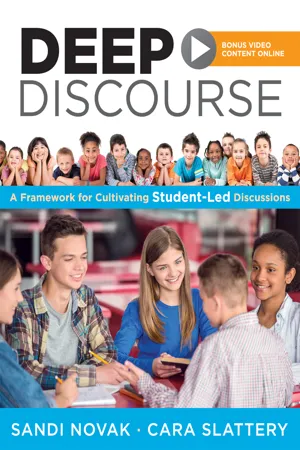
eBook - ePub
Deep Discourse
A Framework for Cultivating Student-Led Discussions—use conversation to raise student learning, motivation, and engagement in K–12 classrooms
This is a test
- 184 pages
- English
- ePUB (mobile friendly)
- Available on iOS & Android
eBook - ePub
Deep Discourse
A Framework for Cultivating Student-Led Discussions—use conversation to raise student learning, motivation, and engagement in K–12 classrooms
Book details
Table of contents
Citations
About This Book
When educators provide explicit instruction, guidance, and feedback to students and let them steer the dialogue, students develop essential critical-thinking, problem-solving, and self-directed learning skills. This book details a framework for implementing student-led classroom discussions that improve student learning, motivation, and engagement across all levels and subject areas. The text features tools, tips, and exercises, plus unrehearsed videos of student-led classroom discussions.
Benefits
- Implement the student-led discussion framework and measure progress with the rubric for student-led discussions.
- Watch videos of real discussions among K–12 students and convey how educators and administrators can best prompt students to engage in their own productive conversations.
- Explore questions for stimulating students' critical thinking in multiple subject areas.
- Examine students' thoughts about being involved in their own student-led discussions.
- Follow "Take Action" prompts to exercise newly acquired knowledge.
- Access free reproducible versions of tools and rubrics featured in the book.
Contents
About the Authors
Introduction
- Articulating the Need for Student-Led Discussions
- Establishing a Discussion Framework for Student Success
- Beginning the Journey
- Experimenting with Different Discussion Formats and Strategies
- Using Discussion in Different Content Areas
- Getting to Deep Discourse
- Pulling It All Together: Tools and Tips
Conclusion
References and Resources
Frequently asked questions
At the moment all of our mobile-responsive ePub books are available to download via the app. Most of our PDFs are also available to download and we're working on making the final remaining ones downloadable now. Learn more here.
Both plans give you full access to the library and all of Perlego’s features. The only differences are the price and subscription period: With the annual plan you’ll save around 30% compared to 12 months on the monthly plan.
We are an online textbook subscription service, where you can get access to an entire online library for less than the price of a single book per month. With over 1 million books across 1000+ topics, we’ve got you covered! Learn more here.
Look out for the read-aloud symbol on your next book to see if you can listen to it. The read-aloud tool reads text aloud for you, highlighting the text as it is being read. You can pause it, speed it up and slow it down. Learn more here.
Yes, you can access Deep Discourse by Sandi Novak,Cara Slattery in PDF and/or ePUB format, as well as other popular books in Pedagogía & Métodos de enseñanza de la educación. We have over one million books available in our catalogue for you to explore.
Information
Table of contents
- Cover
- Title
- Copyright
- Acknowledgments
- Table of Contents
- About the Authors
- Introduction
- Chapter 1 Articulating the Need for Student-Led Discussions
- Chapter 2 Establishing a Discussion Framework for Student Success
- Chapter 3 Beginning the Journey
- Chapter 4 Experimenting With Different Discussion Formats and Strategies
- Chapter 5 Using Discussion in Different Content Areas
- Chapter 6 Getting to Deep Discourse
- Chapter 7 Pulling It All Together: Tools and Tips
- Conclusion
- Appendix: List of Videos
- References
- Index